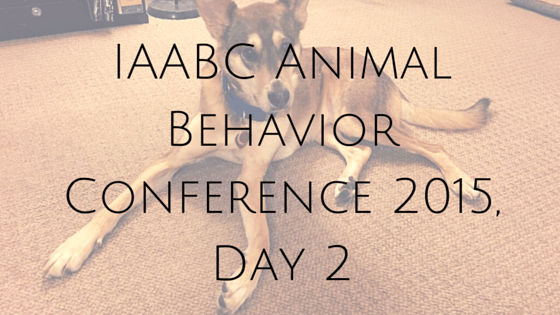Due to the generosity of IAABC President Michael Shikashio, The Modern Dog Trainer was able to send a writer to the Animal Behavior Conference in Chicago, IL. Notes from day 1 can be found here.

Living With And Loving A Pet With Behavior Problems, by Kristin Buller, LCSW and Kelly Ballantyne, DVM
Kristin and Dr. Ballantyne conducted a small research project on the impact that living with a pet with behavior issues can have on the owners. The research consisted of 63 participants, 40 of whom answered all questions. The questions covered how their pet’s behavior impacted their social and personal lives. Their results showed the impact is huge, sometimes devastating. Owners feel stress, guilt, embarrassment, and socially isolated from friends and family. Couples can have increased arguments due to disagreements on how to manage/care for the pet. People can feel judged by society, friends, and even family.
They spoke about how even professionals occasionally come across as judgmental to those with difficult pets. How many times have you heard, “there are no bad dogs, only bad owners.” Imagine the impact that one simple statement has on a person who has tried their hardest and still has a difficult dog.
They said that as trainers, we have a responsibility to keep in the mind how any management instructions we give our clients will impact their lives and possibly create isolation from friends and family. Most of the participants said that their trainers and veterinarians provided hope and trust. That’s not to be taken lightly! Kristin runs a support group for people living with difficult pets, where owners can come and talk to other people who truly understand. No training tips, just emotional support.
They spoke about euthanasia for maybe two minutes, and how it is the last show of love we can give our pets, yet people often don’t extend this grace when the decision is made for a behavioral/mental illness in the pet. This leaves owners again feeling judged and blamed. Just a personal note here, but just in the couple of minutes that this was discussed, the entire room was sniffling and many were wiping eyes. It was profound to me to see how many of us had obviously been touched by a shared experience of euthanizing a beloved pet or helping somebody else come to that decision.
To end, they discussed how trainers are first responders – people reach out to us in a time of crisis. This is a huge responsibility. We might not have the tools for dealing with the emotional crisis and that’s okay. We cannot be trainers and therapists or we get compassion fatigue and burnout. We don’t have to have all the answers. So what can we do?
- Let clients know it’s normal to have these feelings; validate them.
- Let them know it’s okay to still love their pet. When people accept the dog they have, instead of the dog they wanted, everybody is happier.
- Use reflective and empathetic listening.
- Use self-care to avoid compassion fatigue.
- Read a book entitled “Trauma Stewardship: An Everyday Guide to Caring for Self While Caring for Others” by Laura van Dernoot Lipsky.
Introducing Highly Reactive And Aggressive Dogs by Ken Ramirez
Ken received a grant to do research on introducing three reactive/aggressive dogs to each other, using the same techniques used in zoos and aquariums. The research is still proprietary so cannot be shared to those who were not present at the seminar. However, trust me when I say it was fascinating and you should definitely keep your eyes peeled for when it becomes available to the general public.
Simplifying Complex Training Tools by Ken Ramirez
Ken considers an advanced concept anything that ventures beyond “reward desirable behavior and ignore unwanted behavior.” He made sure to specify that just understanding the theory isn’t enough – you must have the practical skills before using a tool, let alone introducing it to a client. He said that training is all about adapting and changing procedures based upon the animal’s behavior. He discussed many different tools that trainers should have in their toolbox:
- Keep Going Signal/Intermediate Bridge/Tertiary Reinforcer
- Jackpots
- No Reinforcement/Reward Markers (NRM)
- Time Outs
- Least Reinforcing Scenario/Stimulus (LRS)
- Differential Reinforcement of Alternate Behaviors
- Recall Signal (not a tool but included in lecture due to frequency of misuse)
- End Of Session Signal
For each of these, he discussed what the science has shown, how and when to use them, and whether he personally uses them or not. He ended by talking about how all tools exist for a reason. Many are very specialized and seldom needed, but we shouldn’t throw them out of the toolbox. We need to understand all the tools and how to use them if we want to help people STOP using them. On the other hand, don’t use a tool just because you have it. Successful use of complex tools depends on thorough understanding of the benefits and challenges of their use.
Final Thoughts Of This Writer
I cannot thank Michael Shikashio and the IAABC enough for his generosity in providing The Modern Dog Trainer a ticket to this conference. It was an absolutely amazing experience and I learned so much. It is frustrating as I know the blogs I wrote of this conference cannot convey the sheer brilliance of the speakers that were present, nor the massive amount of information they so generously shared with all of us.
Get Dog Training Business Tips!
Receive valuable dog training business tips and resources every week! Subscribe to The Modern Dog Trainer now by submitting your name and email below.
[mc4wp_form]




